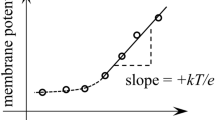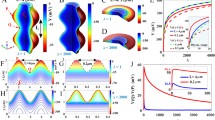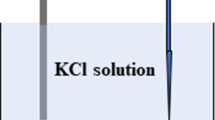Abstract
The role of fixed charges present at the surface of biological membranes is usually described by the Gouy-Chapman-Grahame theory of the electric double-layer where the Grahame equation is applied independently on each side of the membrane and where the capacitive charges (linked to the transmembrane ionic currents) are disregarded. In this article, we generalize the Gouy-Chapman-Grahame theory by taking into account both intrinsic charges (resulting from the dissociation of membrane constituents) and capacitive charges, in the density value of the membrane surface charges. In the first part, we show that capacitive charges couple electrostatic potentials present on both sides of the membrane. The intensity of this coupling depends both on the value of the membrane specific capacitance and the transmembrane electric potential difference. In the second part, we suggest some physiological implications of membrane electric double-layers.
Similar content being viewed by others
REFERENCES
Ben-Tal, N., B. Honig, R.M. Peitzsch, G. Denisov and S. McLaughlin (1996). Binding of small basic peptides to membranes containing acidic lipids: theoretical models and experimental results. Biophysical Journal 71: 561–575.
Bikerman, J.J. (1970). Electric Surface Phenomena. In: E.M Loebl (ed.), Physical Surfaces (Vol. 20 in Physical Chemistry), pp. 370–433. New York, Academic Press.
Chandler, W.K., A.L. Hodgkin and H. Meves (1965). The effect of changing the internal solution on sodium inactivation and related phenomena in giant axons. Journal of Physiology (London) 180: 821–836.
Costalat, R. and J. Burger (1996). Effect of enzyme organization on the stability of Yates-Pardee pathways. Bulletin of Mathematical Biology 58: 719–737.
Eyges, L. (1980). The Classical Electromagnetic Field. Dover, New York.
Forsten, K.E., R.E. Kosack, D.A. Lauffenburger and S. Subramaniam (1994). Numerical solution of the nonlinear Poisson-Boltzmann equation for a membrane-electrolyte system. Journal of Physical Chemistry 98: 5580–5586.
Frankenhaeuser, B. and A.L. Hodgkin (1957). The action of calcium on the electrical properties of squid axons. Journal of Physiology (London) 137: 218–244.
Genet, S. and J. Cohen (1996). The cation distribution set by surface charges explains a paradoxical membrane excitability behavior. Comptes Rendus de l'AcadÈmie des Sciences Paris Série 3 Sciences de la Vie/Life Sciences 319: 263–268.
Genet, S. and R. Costalat (1999). The role of membrane electrostatics in the regulation of cell volume and ion concentrations. Journal of Biological Systems 7: 155–182.
Gileadi, E., E. Kirowa-Eisner and J. Penciner (1975). Interfacial Electrochemistry. An Experimental Approach. Addison-Wesley, Reading.
Grahame, D.C. (1947). The electrical double layer and the theory of electrocapillarity. Chemical Reviews 41: 441–501.
Hainsworth, A.H. and S.B. Hladki (1987). Effects of double-layer polarization on ion transport. Biophysical Journal 51: 27–36.
Hille, B. (1992). Ionic channels of excitable membranes. Sinauer Press, Sunderland.
Hodgkin, A.L. and P. Horowicz (1959). The influence of potassium and chloride ions on the membrane potential of single muscle fibers. Journal of Physiology (London) 148: 127–160.
Honig, B. and A. Nicholls (1995). Classical electrostatics in biology and chemistry. Science 268: 1144–1149.
Honig, B., W.L. Hubbell and R.F. Flewelling (1986). Electrostatic interactions in membranes and proteins. Annual Review in Biophysics and Biophysical Chemistry 15: 163–193.
Kabakov, A. (1994). The resting potential equations incorporating ionic pumps and osmotic concentration. Journal of theoretical Biology 169: 51–64.
Laüger, P. (1991). Electrogenic Ion Pumps. Sinauer Associates, Sunderland.
Laver, D.R. and K.A. Fairley-Grenot (1994). Surface potentials near the mouth of the large-conductance K+ channel from Chara australis: a new method of testing for diffusion-limited ion flow. The Journal of Membrane Biology 139: 149–165.
McLaughlin, S. (1989). The electrostatics properties of membranes. Annual Review in Biophysics and Biophysical Chemistry 18: 113–136.
Nelson, A.P., P. Colonomos and D.A. McQuarrie (1975). Electrostatic coupling across a membrane with titratable surface groups. Journal of theoretical Biology 50: 317–325.
Ohmori, H. and M. Yoshii (1977). Surface potential reflected in both gating and permeation mechanisms of sodium and calcium channels of the tunicate egg cell membrane. Journal of Physiology (London) 207: 429–463.
Peitzsch, R.M., M. Eisenberg, K.A. Sharp and S. McLaughlin (1995). Calculations of the electrostatic potential adjacent to model phospholipid bilayers. Biophysical Journal 68: 729–738.
Ricard, J., N. Kellershohn and G. Mulliert (1992). Dynamics aspects of long distance functional interactions between membrane-bound enzymes. Journal of theoretical Biology 156: 1–40.
Roux, B. (1997) Influence of the membrane potential on the free energy of an intrinsic protein. Biophysical Journal 73: 2980–2989.
Thellier, M. and C. Ripoll (1992). Bases thermodynamiques de la biologie cellulaire. Masson, Paris.
Trotier, D. and K.B. Doving (1996). Direct influence of the sodium pump on the membrane of vomeronasal chemorecptor neurones in frog. Journal of Physiology (London) 490: 611–621.
Warshel, A. and S.T. Russell (1984). Calculations of electrostatic interactions in biological systems and in solutions. Quarterly Reviews of Biophysics 17: 283–422.
Westerhoff, H.V. and G.R. Welch (1992). Enzyme organization and the direction of metabolic flow: physicochemical considerations. Current Topics in Cellular Regulation 33: 361–390.
Winisky, A.P., M. Eisenberg, M. Langner and S. McLaughlin (1988). Fluorescent probes of electrostatic potential 1 nm from the membrane surface. Biochemistry 27: 386–392.
Yao, J-A., N.C. Saxena, M.R. Ziai, S. Ling and G.N. Tseng (1995). Effects of n-Dodecylguanidine on A-type potassium channels: role of external surface charges in channel gating. Molecular Pharmacology 48: 160–171.
Zhou, W. and S.W. Jones (1995). Surface charge and calcium channel saturation in bullfrog sympathetic neurons. Journal of General Physiology 105: 441–462.
Zhou, W. and S.W. Jones (1996). The effects of external pH on calcium channel currents in bullfrog sympathetic neurons. Biophysical Journal 70: 1326–1334.
Author information
Authors and Affiliations
Rights and permissions
About this article
Cite this article
Genet, S., Costalat, R. & Burger, J. A Few Comments on Electrostatic Interactions in Cell Physiology. Acta Biotheor 48, 273–287 (2000). https://doi.org/10.1023/A:1010229531210
Issue Date:
DOI: https://doi.org/10.1023/A:1010229531210




